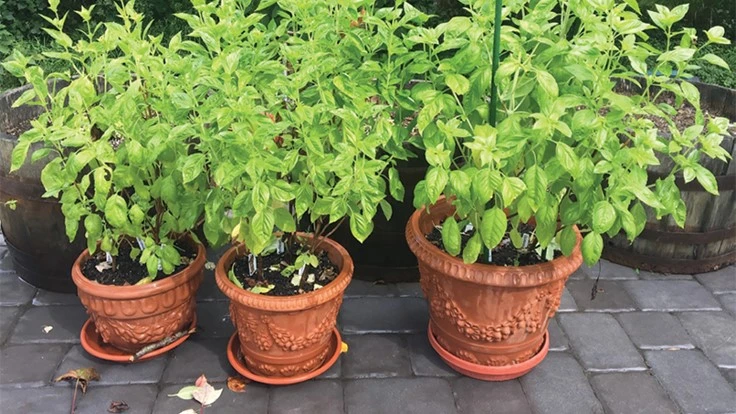

Four new sweet basil varieties resistant to downy mildew disease, which destroys leaves, are now being sold to home gardeners and commercial farmers across the U.S. after years of breeding and selection at Rutgers University.
Two of the four varieties also show high resistance to Fusarium wilt, another soil-borne disease.
The four new downy mildew-resistant (DMR) sweet basils are Rutgers Devotion DMR, Rutgers Obsession DMR, Rutgers Passion DMR and Rutgers Thunderstruck DMR. These varieties of sweet basil became available to commercial growers last spring and are now available to home gardeners.
James E. Simon, distinguished professor of plant biology, Robert Pyne, former doctoral student, and Andy Wyenandt, extension specialist in vegetable pathology, led the plant breeding team that developed the new basils. The team included collaborators in Florida and on Long Island. Here, Simon, who has spent decades collecting and breeding basils from around the world, discusses the four new Rutgers varieties.
What are the advantages of growing the new Rutgers varieties of sweet basil?
After a decade of intense breeding work, these new Rutgers varieties are highly resistant to downy mildew. You might still find some disease spores on the bottom sides of leaves and yellow leaf discoloration on the upper side, but home gardeners won’t have to throw out their basil due to the lack of leaves as many gardeners and growers have discovered since 2009.
You can grow basil all summer and into the fall.
Where can the new Rutgers varieties be grown?
These plants were originally developed for commercial field and greenhouse growers, yet we found that each grows nicely and easily in plastic or ceramic pots on porches and in home gardens.
Basil can also be grown indoors, but keep in mind the plant thrives in light, heat and a lot of water. Put it in an open window on a kitchen counter where the sun comes in.
When should basil be planted and how should it be cared for?
Homeowners can plant these basils after the last date of frost-inducing temperatures in the spring. These basils grow like all other sweet basils, and in our area the plants will continue to grow through September or into October, depending on the weather and if the plants are kept pruned and sheltered from the cold.
The key with basil is to keep it pruned and keep the plant from flowering, which can make the leaves taste bitter. By removing the flowers, the plant sends out side branches that result in more leaves and keeps it vegetative for longer periods. If possible, water in the morning and allow for good aeration and drainage in the growing media. Personally, I always water my basils underneath the foliage to keep the leaves dry.
What else should people know about the new Rutgers basil varieties?
These plants are vigorous. You can cut and harvest the leaves many times over many months. They were developed and bred using traditional breeding, including the crossbreeding of thousands of plants.
These varieties are not GMO. There’s no genetic engineering at all — just-good old-fashioned creative plant breeding. For more information on the Rutgers basil breeding program and sources for purchasing the new Rutgers DMR sweet basil seed, please visit the Rutgers New Jersey Agricultural Experiment Station’s All-Star Varieties website: breeding.rutgers.edu.

Explore the August 2019 Issue
Check out more from this issue and find your next story to read.
Latest from Garden Center
- Les Evans promoted to DRAMMwater segment manager, Al Zylstra to retire
- Hoffmann Family of Companies to acquire N.G. Heimos Greenhouses
- GIE Media Horticulture Group wins five regional 2025 Azbee Awards of Excellence
- QR Zipper partners with American Floral Endowment on Sustainabloom donations
- VIDEO: How Kansas City garden centers are fostering community
- Pennsylvania Horticultural Society announces 2025 Gold Medal Plant winners
- How are microplastics affecting plant photosynthesis?
- A nation of gardeners: A history of the British horticulture industry





